Steeped in history, spanning miles of Mediterranean and Atlantic coastline, and boasting exciting attractions, Morocco is a sightseer's paradise. Part of the appeal is the inviting climate but there is so much more to this diverse and historically rich country than meets the eye. Within the enchanting medieval medinas of Fez and Marrakech, where snake charmers blow their hypnotic melodies amid the smell of the tanners' yards and the hustle and bustle of the open-air markets, the fascinating and exotic soul of Morocco can really be glimpsed. With Phoenician, Hellenic, Carthaginian and Roman civilisations all having passed through Morocco, it's also worth revelling in the immensity of the country's past by exploring its countless museums, palaces, mosques, tombs and ruins.Furthermore, adventurous travellers can head south to explore the hot desert sands of the Western Sahara, and see breathtaking landscapes which are a privilege to behold; or for a completely unexpected holiday experience, head deep into the High Atlas Mountains for a skiing holiday with a difference. There are exciting 4x4, horseback and camelback treks to enjoy as well as lovely coastlines to explore.Many of the sights around the cities are best explored on foot, but for those planning on criss-crossing the country, trunk-line trains run through the heart of Morocco, connecting over one hundred stations spread out over 1,184 miles (1,907km) of track. Bus travel is also a popular mode of transport.
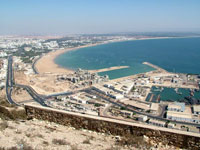
The holiday destination of Agadir, south of Marrakech, is contemporary and fresh, fast developing into Morocco's major resort town. The reason? Agadier's magnificent sandy beaches.Agadier was rebuilt after an earthquake in 1961 which wiped out most of its historic heritage as an important seaport and centre for caravans traversing the Sahara. The rebuilt city has been modelled as a tourist destination and fishing port, favoured by package tours, particularly as a starting point for excursions into the Western Sahara to the south. Agadir has a lovely promenade along the coast and a vibrant restaurant and café culture tailored towards tourists. The nightlife is also fast developing and the shopping scene shouldn't disappoint.Conveniently, Agadir is the city in Morocco most tolerant of foreign customs which helps most tourists feel most comfortable, and helps to ease them into the their travels further into the country. The town is conveniently located near popular attractions such as the walled city of Taroudannt and the Massa Lagoon, and contains a number of luxury hotels and excellent golf courses. Agadier makes for either a comfortable start to a Moroccan journey, or useful respite for those who have already seen much of the country already.
Aït Benhaddou is an ancient fortified city (ksar) situated along the former caravan route between the Sahara and Marrakech. It is certainly one of the most breathtaking tourist attractions in Morocco. A UNESCO World Heritage Site, Aït Benhaddou is not only a place of great historical significant that stands as a record of Maghreb architectural practices, but is so immediately evocative of the most romantic visions of ancient Arabia that visitors may mistake it for a fanciful mirage. The buildings, constructed against a mountain and surrounded by steep defensive walls, are all built from moulded earth and clay brick, and the sight of them, ornamented with decorative motifs and appearing blood-red in the evening light, is so stirring that Aït Benhaddou has been featured in numerous Hollywood films (from Lawrence of Arabia to Gladiator). Providing some picture-perfect examples of kasbahs and medinas, no trip to Morocco would be complete without a visit to Aït Benhaddou. The city is most picturesque at sunrise and sunset, so visitors should remember to pack their cameras. Aït Benhaddou is a 3.5 hour drive south east of Marrakech.
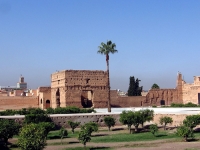
The El Badi Palace('the incomparable palace') consists of the remnants of a glorious palace built by the Saadian King Ahmad al-Mansur, in 1578. The original building is thought to have had about 360 rooms, a courtyard and a pool, and was decorated with Italian marble and large amounts of Sudanese gold. It also had a small, underground jail where the king kept his prisoners. The design of the palace was influenced by Granada's Alhambra, but the original palace was torn apart by Sultan Mawlay Ismail.Today, the once luxurious palace is a ruin consisting of some intact rooms and numerous walls, terraces, gardens and foundations. The underground jail can still be explored and there are a number of beautiful mosaics surviving, but visitors have to use some imagination to conjure up the onetime grandeur of the place. The ruins still retain some their romance, but very little effort has gone into maintaining or preserving the site. Despite the ramshackle nature of the attraction anybody with an interest in history and archaeological sites should enjoy exploring the site. There is little or no shade so travellers should go prepared for the sun and should avoid the hottest part of the day. There is a small admission fee.
Address : Ksibat Nhass, Marrakesh, Morocco.
E-mail : [email protected]
Website : www.palais-el-badi.com/en
Telephone : +212 5243 78163
Transport : Like much of Marrakech, a short walk or shorter taxi ride are the most convenient options.
Opening times : 8am-5pm every day.
Admission : About MAD 10.

The Majorelle Garden is a botanical garden designed by the French artist, Jacques Majorelle, in 1924. Previous owners have included Pierre Bergé and Yves Saint-Laurent (whose ashes were scattered there when he died in 2008). The garden is also home to the Islamic Art Museum of Marrakech, which houses an exhibit of North African textiles from Saint-Laurent's personal collection, and paintings by Majorelle.The garden is home to more than 15 bird species endemic to North Africa, and full of ponds and water features. The garden took 40 years to create. It is one of the most popular tourist sites in Morocco and a must for all visitors. The villa in the centre of the garden, which houses the museum, is a stunning blue, accented with other bright colours, a mixture of classic Moroccan features and art deco creativity. This is a particularly good attraction for a hot day as the gardens are shaded and always seem much cooler than the rest of the city. There is a lovely café in a shaded courtyard for refreshments and a gift shop selling YSL products, among other things. Although the gardens can be explored in under an hour, this is a place that can be enjoyed for a few hours, escaping the bussle of Marrakech.
Address : Rue Yves Saint Laurent، Marrakesh 40090, Morocco
Website : www.jardinmajorelle.com
Telephone : +212 5243 13047
Opening times : Opening times vary according to season: October to April, 8am to 5:30pm; May to September, 8am to 6pm; and during Ramadan, 9am to 5pm.
Admission : MAD 70 (garden), MAD 30 (museum). Concessions are available.
The village of Ouirgane, in the foothills of the Atlas Mountains, about 90 minutes' drive from Marrakech, stands at the centre of a popular resort area, where summers are cooler and winters less harsh than those experienced in the city. The surrounding Berber countryside offers picturesque villages and hamlets to explore, set in pine forests full of wildlife and groves of fruit trees, alongside streams cascading down from the High Atlas Mountains and fields of wild flowers. The soil is a striking red, which emphasises the luxuriant greenery and makes the landscapes slightly otherworldly in some lights. The area is also known for its extraordinarily beautiful rose gardens.The village is mainly just used as a peaceful place to relax, and as a hub for outdoor activities like hiking, mountain-biking and horseriding. There are a few attractions in town, however, including the Tin Mal Mosque, what remains of the somewhat ruined old kasbah, and a small souk (market) every Thursday, which is noted for its traditional Berber pottery. The mild climate is what makes Ouirgane a year-round attraction, the best time to visit the town and surrounding area is between March and May, or between mid-September and December.
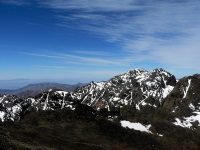
A ski resort in the desert! Thick snow envelops the Jebal Oukaimeden mountain peak during the winter months (usually January and February), just a 46 mile (74km) drive from Marrakech. The town of Oukaimeden, which can be reached by taxi or car, is well-equipped with the basics for skiers, with restaurants, ski equipment to rent, comfortable hotels set in lush greenery and backed by blue mountains, as well as ski schools for beginners.Skiers can ascend the mountain by donkey or camel, but there are also some modern ski lifts. Five ski runs traverse down from the dizzying heights of Jebel Attar and there are nursery slopes and some intermediate runs. The ski equipment for rent can be somewhat outdated and visitors should be wary of renting from unofficial shops. At the top of the chair lift young men typically vie for jobs as guides down the mountain and many visitors choose to hire them for at least one run because the routes are difficult to discern.Oukaimeden is one of the best ski resorts on the African continent, although of course there is not much competition. The resort is tiny and the facilities very basic compared to European equivalents, but there is a lot of fun to be had at Oukaimeden. The resort is notably Moroccan in style and this gives it an eccentric feel for those used to European ski resorts. A lot of development is due to begin at Oukaimeden, which will no doubt make it more typical, and more convenient.
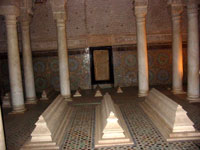
The beautiful necropolis was built by the Saadian Sultan Ahmed el Mansour in the late 16th century as a final resting place for him and his successors. Having fallen into disrepair, the tombs were rediscovered in 1917 and carefully restored to their former splendour. There are 66 indoor tombs, lavishly decorated with colourful, intricate mosaics. The central mausoleum, the Hall of the Twelve Columns, is exceptionally ornate with a high, vaulted roof, furnished with stunning carved cedar panels and columns of grey Italian marble. The tombs are spread through three rooms and there are gardens outside the building where the graves of soldiers and servants can be seen. The Saadian Tombs are a remarkable tourist attraction but they don't require much time and can be fully appreciated in under an hour. The tombs are a stop on many sightseeing tours.
Address : Rue de la Kasbah near the city walls in the old city.
E-mail : www.tombeaux-saadiens.com/en/[email protected]
Telephone : +212 654 572205
Opening times : 9am-4pm, every day.
Admission : About MAD 70 is charged for entry.
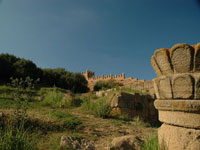
Emerging from the boulevards of the Ville Nouvelle (New Town) of Rabat, one comes across the ruins of Chellah, once the thriving walled Roman port city of Sala Colonia, abandoned in 1154 in favour of Salé across the river mouth.In the time of the Almohads the site was used as a royal burial ground, and following this, the Merenid sultan, Abou El Hassan, added some monuments and the striking main gate in the mid-14th century. Just inside the gate are Roman ruins dating from 200 BC, which include a forum, a temple and a craftsmen's quarter.The citadel is now part of a garden and in spring the ruins are surrounded by a beautiful variety of flowers. The Chellah Gardens are entered through an ancient gateway created by the Almohads and notable ruins inside, apart from the Roman remains, include what is left of the small mosque dedicated to Abou Youssef, several elaborate tombs, and a stone minaret in the centre of the grounds. Visitors are welcome to wander freely and none of the ruins are off limits. The garden is a lovely place to spend some time and since 2005 has been the venue of an annual international jazz festival, Jazz au Chellah.
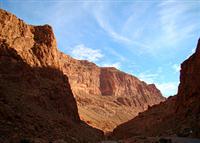
The Todra Gorge, a canyon on the eastern side of the High Atlas Mountains, is undoubtedly one of the most spectacular natural attractions that Morocco has to offer. Nature lovers who feel starved in the choked streets of Morocco's cities can simply take the trip to the Todra Gorge (most easily accessed from the town of Tinerhir) where they will be rewarded by the experience of a lifetime. To put the grandeur of the gorge into perspective, consider that over its final 1,950 feet (600m), the canyon narrows to a rocky passage only 33 feet (10m) wide, while the sheer walls rise up 984 feet (300m) on either side.Sunlight only reaches the bottom of the Todra Gorge, where an ice-cold river flows, for a few hours each morning, and night-time temperatures regularly fall below freezing. Although a place of awesome ruggedness, tourists need not worry about being too far 'off the beaten track' as a well-maintained hiking path runs through the gorge, and there are restaurants and even a hotel situated about halfway along. In fact, those in search of a tranquil wilderness may be disappointed as the gorge's popularity ensures that it is sometimes quite crowded. Climbing is a popular activity in the gorge and several adventure tour operators offer climbing trips and equipment.
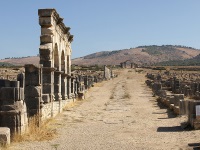
Volubilis, near the Moroccan town of Meknes, situated between Rabat and Fez, was a central Roman administrative city in Africa from around the third century BC, built atop a previous Carthaginian city. Volubilis was unique in that it was not abandoned after the Romans lost North Africa to the Arabs, with even the Latin language living on in the area for several centuries.Volubilis remained inhabited until the 18th century, when it was demolished to provide building materials for the palaces of Moulay Ismail in nearby Meknes, which meant that a great deal of the Roman architectural heritage was lost.Today the ruins are a UNESCO World Heritage Site and consist of some well-preserved columns, a basilica, a triumphal arch and about 30 magnificent mosaics. It is recommended that you have a knowledgeable guide for this site, as it is greatly enriched by knowing the background and context of what you are seeing. It takes a few hours to stroll around all the ruins and visitors should be sure to come prepared for the baking sun as there is little shade - drinking water, sunscreen and a hat will make all the difference, and comfortable walking shoes are also essential.

Travel Guide powered by Word Travels, copyright © 2023 Globe Media Ltd. By its very nature information in this travel guide is subject to change at short notice and travellers are urged to verify information on which they're relying with the relevant authorities. Neither Globe Media Ltd nor Travel Vogue can accept any responsibility for any loss or inconvenience to any person as a result of information contained above.